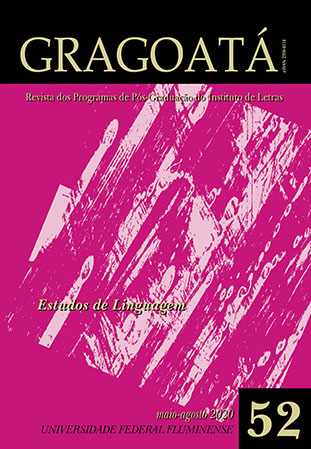A semântica da construção ditransitiva em perspectiva diacrônica
DOI:
https://doi.org/10.22409/gragoata.v25i52.40821Palavras-chave:
Linguística Funcional Centrada no Uso. Gramática de Construções. Construção Ditransitiva. Semântica construcional.Resumo
Este artigo tem como foco a construção ditransitiva do português do Brasil, com o objetivo de examinar sua evolução semântica. Para tanto, compara manifestações dessa construção nos séculos XVIII e XX a fim de investigar se houve mudança em sua morfossintaxe e na classe semântica dos verbos que a instanciam. A abordagem teórica conjuga pressupostos e categorias analíticas da Linguística Funcional Centrada no Uso (FURTADO DA CUNHA, M. A.; BISPO, E. B.; SILVA, 2013a) e da Gramática de Construções (GOLDBERG, 1995; TRAUGOTT; TROUSDALE, 2013; HILPERT, 2014). Os resultados obtidos indicam que, tanto no século XVIII como no século XX, em seu sentido prototípico, a construção ditransitiva conceitualiza um evento de transferência física, em que um participante animado (Sujeito) transfere um objeto (Objeto Direto) para uma entidade humana (Objeto Indireto). Além disso, não foi constatada mudança na classe semântica dos verbos que podem instanciar extensões do sentido central dessa construção.
Downloads
Downloads
Publicado
Edição
Seção
Licença
AUTORIZAÇÃO
Autores que publicam em Gragoatá concordam com os seguintes termos:
Os autores mantêm os direitos e cedem à revista o direito à primeira publicação, simultaneamente submetido a uma licença Creative Commons Atribuição 4.0 Internacional (CC BY 4.0), que permite o compartilhamento por terceiros com a devida menção ao autor e à primeira publicação pela Gragoatá.
Os autores podem entrar em acordos contratuais adicionais e separados para a distribuição não exclusiva da versão publicada da obra (por exemplo, postá-la em um repositório institucional ou publicá-la em um livro), com o reconhecimento de sua publicação inicial na Gragoatá.
A Gragoatá utiliza uma Licença Creative Commons - Atribuição CC BY 4.0 Internacional.











